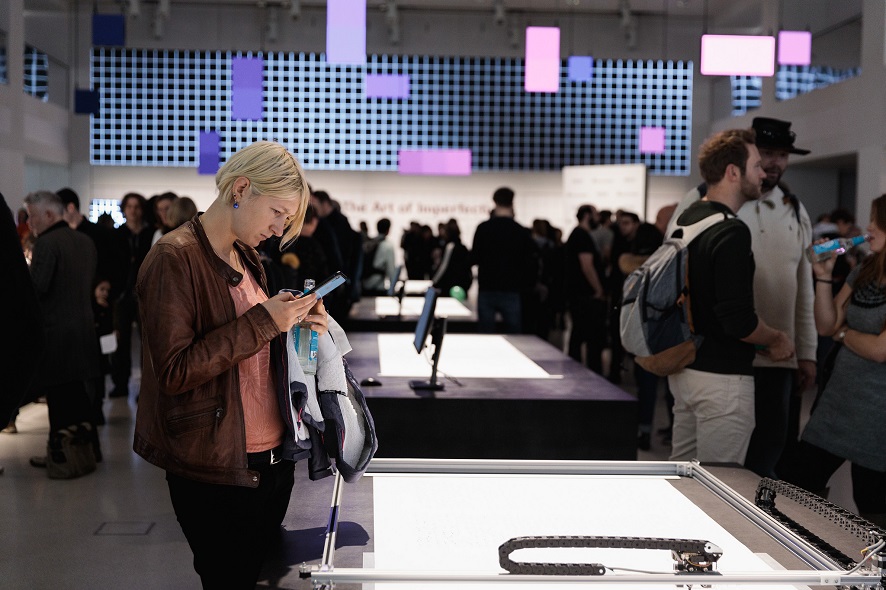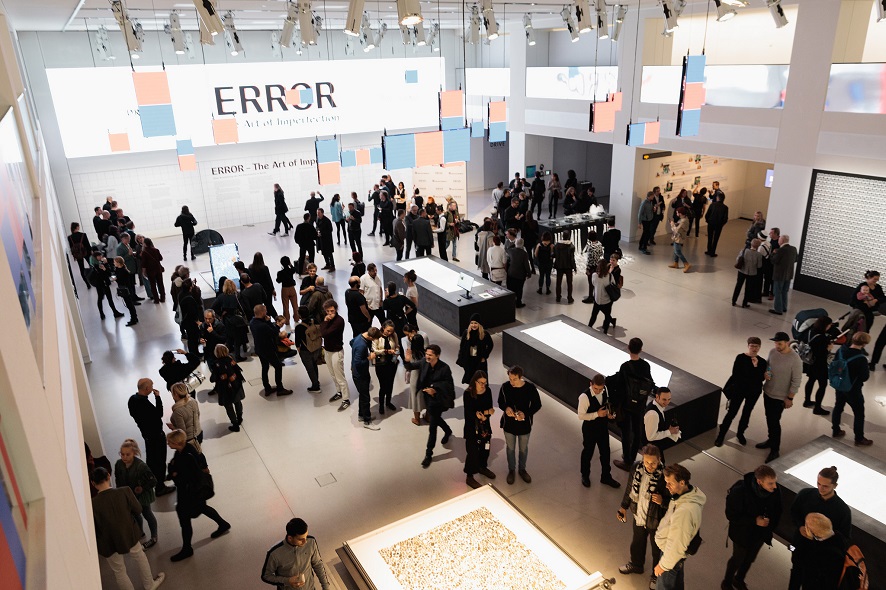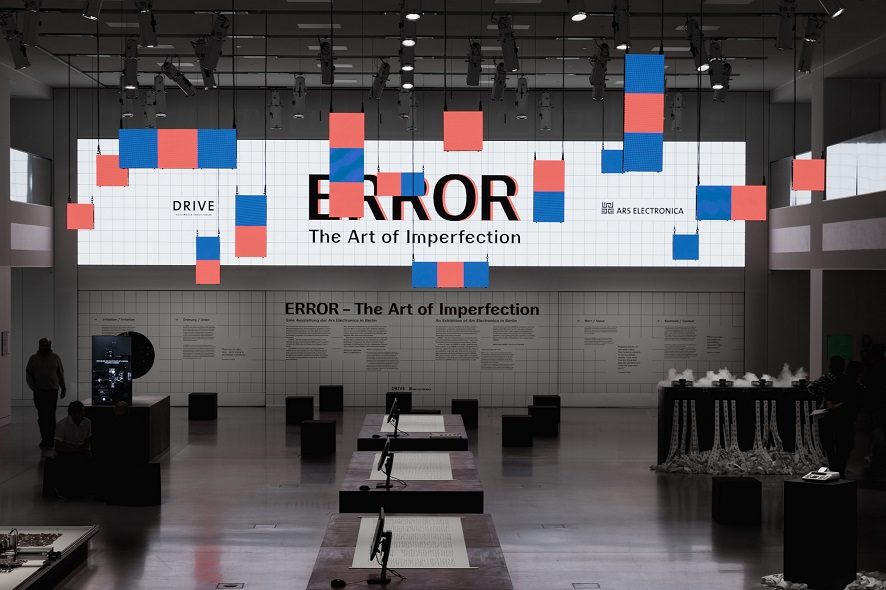A mistake, an error, need not always be negative. Instead, it can simply be a deviation from the norm. It creates a space of freedom where – if all goes well – something new can emerge. What does that mean for us as human beings and as a society? The exhibition “ERROR – The Art of Imperfection,” still showing until March 3 at DRIVE. Volkswagen Group Forum, explores that question. The joint exhibition project by VW and Ars Electronica Export is now appearing in the auto showroom in Berlin Mitte for the seventh time. For this year’s show, an international group of artists present their ideas of what an error can be, using the keywords Irritation, Order, Value, and Control.
Manuela Naveau, curator and head of Ars Electronica Export, Letitia Lehner, founder of MOOI Design and director of design for the exhibition, and Claudia Rohrmoser, video artist, gave us their thoughts on the exhibition in this group interview.
The theme of this year’s exhibition at DRIVE Volkswagen Group Forum is “ERROR – The Art of Imperfection.” What kind of thought process did you go through with this theme?
Claudia Rohrmoser: From the very beginning, I felt the Error aspect was associated with a welcome and necessary “evil” in the creative process. My experience with experimental and digital art leads me to see mistakes as an essential factor for producing new ideas, just as accidents do. Ideally, when an error occurs it is a symptom of a failed thought process or design process and it forces you to rethink things. On the other hand, mistakes don’t always have positive or productive effects. I recently worked on a documentary about the power of software companies, which was partly about security gaps and computer viruses. The fact that malicious programs like Wannacry can cripple entire supply systems is something I find threatening and reassuring at the same time.
Personally, critical engagement with perfection and deviation in designing computer-generated images is something that’s very important to me because when I engage with the digital, I’m actually seeking a natural chaos where none exists. I also like exploring themes that I don’t know very much about, and there it’s inevitable that you’ll make mistakes.

Manuela Naveau, Claudia Rohrmoser and Letitia Lehner. Credit: vog.photo
This theme is not new for Ars Electronica; the 2018 Ars Electronica Festival was also dedicated to ERROR. How does the exploration of a theme like this change over time?
Manuela Naveau: The way it is explored at the Ars Electronica Festival is much broader, much more diverse, and very multifaceted. With the exhibition in Berlin, the curatorial walks or the conversations with artists give us a whole other opportunity to go into it in depth and figure out what actually makes an error an error. Traditionally, at least in our culture, the term has a negative connotation. But if you look at the word objectively, it’s really only about a deviation from what you expected; that doesn’t have anything to do with positive or negative. It’s just a fact, a discrepancy. It’s the context that ultimately makes the discrepancy, the error negative or positive. So we settled on four thematic areas: value, control, order, and irritation. These allow us to investigate the error from four different viewpoints. We want to learn to see the importance of each context.

Credit: vog.photo
It’s not only the length of the exhibition in Berlin that’s different from the Ars Electronica Festival, it’s also the location. You’re going from the old industrial facilities into the more upscale DRIVE. Volkswagen Group Forum– what kind of possibilities does this open up?
Claudia Rohrmoser: This space offers really high-level media technology of the kind you hardly ever get to use in an artistic context. The most obvious thing is the big LED screen on the wall. If you don’t use it, it’s a waste, or it looks like a big black hole in the wall. If you use the screen to show videos like at a cinema or a convention, it quickly steals the show from the exhibits. So I decided to tackle it head on by putting even more LED panels in the space. They set off the screen so it looks like it’s exploding forwards and, above all, they fragment the big widescreen.
I’m especially happy that we were able to integrate the wave field synthesis system thanks to our creative partners from TAUCHER Sound. The sound designers provided the know-how and the broader perspective on design that was needed for this complex 3D audio equipment. Supported by the sounds in the room, the light wanders through the LED panels in all directions, achieving an audiovisual activation of the airspace that is usually quite difficult to design into an exhibition.
Letitia Lehner: For us it was also an amazingly cool opportunity, especially with regard to the technology there. There’s a huge number of opportunities for presenting multimedia content, whether it’s the big LED screen, or all the monitors, the sound system, the media and show control system Pandora Box, the light…at DRIVE you are confronted with state-of-the-art technology. Of course it also has some inherent difficulties, because after all, it is a white cube optimized for presenting cars. But I have a very positive view of all the things you can do there with technology. We really wanted to make full use of the technical potential this year.
Manuela Naveau: With the possibilities that the DRIVE offers, we can think of an exhibition quite differently – not statically, but as a stage scenery. I wanted to integrate a static exhibition setting aesthetically into a theatrical process. Exhibition architecture becomes exhibition scenery and Letitia and I quickly agreed to give the exhibition design a feeling of life, a feeling that something is happening there. In our case: there is a sort of cycle lasting 15 minutes, where the exhibition keeps changing. We were very motivated by the idea of bringing this theatrical way of thinking into an exhibition.

Credit: vog.photo
How was that idea ultimately implemented?
Manuela Naveau: We knew right away that we needed someone with a theater background, or someone who works with stages and scenery and knows the right way to handle dramaturgical processes. That’s how Claudia came on board. We considered how the space could be scenically expanded, how it could be conceived as stage scenery you can walk through, where artistic ideas are displayed. The next step was that we didn’t want to stick with just the one screen. Instead, we wanted to have this mighty screen explode into the space, so we hung up extra LED panels. So we’re getting away from the two-dimensional screen, becoming three-dimensional, going into the space and having it play out as a whole. And then there are the art exhibits! What I’m especially happy about is that we really succeeded in finding a balance between theatrical development and the other works of art. Neither one is being dominated by the other. Each area has a certain time where it’s emphasized and comes into the spotlight, in the truest sense of the word. Claudia figured out exactly how to use the LED wall, the other screens, the light system, and the Pandora Box for presenting media.
Claudia Rohrmoser: Because of my background as a video designer for stage scenery, video performances, and media installations, I was focused on the dynamic and sometimes almost humanoid character of the exhibits on the one hand, and on the other, the impressive media system at VW DRIVE. It was clear to me that I wanted to work with a purely media-based scenography, without constructed elements, that uses color, light, and rhythm as defining elements. This is also influenced by the material characteristics of the LED panels, which are extremely well-suited to displaying vibrantly clear colors and black-and-white contrasts. So the concept was principally based on the material I found there as well as, of course, the curatorial and graphic concept for the exhibition. Then, after the first brainstorming session with Manuela and Letitia, we settled pretty quickly on “calibration,” in terms of a measurement process for determining deviations from the norm, as our overarching theme. We reached a common denominator, not just aesthetically through the graphic elements and ideas from the screen test images, but also because this theme offered a good starting point for the moving-image concept. We worked on a project pitch and after our concept was accepted, I brought Florian Kühnle on as an artistic partner to work on real-time systems and generative processes. With him, I developed the narrative and the visual implementation.

DIN / Claudia Rohrmoser, Florian Kühnle. Credit: vog.photo
The installation that resulted from this process is called “DIN.” It makes good use of elements from the exhibition design …
Claudia Rohrmoser: The installation tells about a complex system such as the Internet of Things or something like that in which many small elements have to work together. Occasionally, an error creeps in, and sometimes too many little errors accumulate and it crashes. The system is always trying to contain the errors through standardization and calibration – you could say it dreams of being in an ideal condition without ever being able to achieve that completely. The media system does a kind of self-test to determine its irregularities, which then lead to a malfunction followed by a calibration ritual. But this restoration routine does not lead to improvement. Instead, it raises the question of what the normal condition is and what the error is, and whether the “normal” doesn’t actually include a certain amount of error.
The title DIN, a well-known abbreviation for “Deutsche Industrienorm” (“German industrial norm”) came about later and is a reference to the location. Without norms, the car industry wouldn’t be able to produce a single safe and affordable car. An example of standardization processes that are necessary for survival is the introduction of global time. Before global time, there used to be an unbelievable number of train crashes in the US. In our installation, all the screens, lights, and loudspeakers in the room start going crazy every 15 minutes and surrendering to the synchronized moment of error. Then the media systems undergo a standardization phase in which various calibration methods are used. Even the screens outside on Friedrichstrasse participate in the error moment.
Letitia Lehner: For us, the starting point was this perfect exhibition space, this white cube that provides an optimal setting for the exhibits. We defined the scenario as the exhibition standard. So to deviate from that and make an error something you can really experience, we began to dismantle and break up its normal conditions. We took a lot of inspiration from the test pattern that traditionally marked the end of broadcasting on TV. In our work we always approach topics from a very visual standpoint and here the identity of the exhibition space was our priority. So we wanted to generate this test pattern in the space as well. What happens is that after the normal condition of the exhibition there is a moment of error, the test pattern dissolves, the pixel patterns break down, colors dissipate, try to recalibrate themselves, run through the whole color spectrum and produce completely unexpected results, including in the sound system. We tried to think through this moment of error up to the smallest detail. So, for example, our CI colors are there again, red and royal blue – red is the color of error and in the digital world, at least the world of Windows computers, royal blue represents the screen of death. We even work with fragmentation in the typography; the writing comes apart and keeps putting itself back together. It’s a journey from normal conditions through fragmentation to recalibration, and that is actually something you can see in every design detail. You also see it in the reaction of visitors: there really is a moment of irritation when the moment of error begins in the exhibition. Even if they are already absorbed in other works of art …

Robot, Doing Nothing / Emanuel Gollob. Credit: vog.photo
… and those, of course, are also exploring the theme of error. What are the highlights of the exhibition in your opinion?
Letitia Lehner: My personal highlight is “Robot, Doing Nothing” by Emanuel Gollob. The scenography, the setting, and the positioning are extremely beautiful. We made a conscious decision to divide the space up in this way so you don’t just go straight into the big exhibition room. Instead, there are two spatial installations: first this meditative moment with “Robot, Doing Nothing” and then the multimedia installation.
Manuela Naveau: The nice thing about “Robot, Doing Nothing” is also that Emanuel and his team even got involved in the theatrical production – to the extent that Emanuel matched the wires on the robot to the blue and red of our CI! Even the robot plays a part in the error moment in the exhibition. When the moment comes, the robot stops making his calm motions, stands still for a moment, makes another motion and then goes back to his meditative pastime. So the moment of irritation can be clearly seen in this robot. On one hand you get caught up in the motions of the robot, you have the illusion of an apparent working motion, but on the other hand there’s the irritation – it’s just totally impressive.

Jller / Prokop Bartoníček, Benjamin Maus. Credit: vog.photo
Another work that I like a lot is “Jller” by Prokop Bartoníček and Benjamin Maus. I’ve always wanted to show this work in its full complexity. It’s about a machine that does nothing but organize a collection of rocks from the Jller river. Like “Robot, Doing Nothing,” it’s a work that you can watch for hours. You don’t know what principles of organization this machine is programmed with but the longer you watch it, the more you have the impression of being able to figure out what principles determine how the machine is organizing and structuring things. I think that’s not only a very poetic and aesthetic approach, but also very interesting in terms of content. For the most part, we don’t know what the agenda is behind certain machines, algorithms, and models – we don’t even have an opportunity to look into it. In spite of that we often try to interpret or think we know how machines are programmed.
I also really like “The Normalizing Machine” by Mushon Zer-Aviv , Dan Stavy and Eran Weissenstern. The work tries to examine how databases are used for machine learning processes and who determines what the standard is. The project also goes over 100 years back into history, to a time when the first photographic databases were created and scientists began to work on categorizing human faces. The French forensic pioneer Alphonse Bertillon had developed a system that was never intended to criminalize the face. But that happened, especially in the Second World War, and now: big data, AI, and a lack of ethical controls mean it’s all happening again. That’s exactly the critique that “Normalizing Machine” is making. And the interactive work is also just beautiful with its aesthetic use of old notecards, and it‘s being presented for the first time in Berlin, I‘m especially happy about that. But actually, I could go into raptures about every work at this exhibition.
Claudia Rohrmoser: I think there is a successful balance between the exhibits, the white space, and the exhibition design. The graphic elements reappear throughout the exhibition without interfering too much in the function or autonomy of the works of art. As Letitia said already, it’s not a traditional museum-type exhibition in the white cube, nor is it a big show spectacle. I think that’s because we agreed on a guideline for the aesthetics and content that can be derived from the curatorial concept but can also be integrated into the existing architecture without detracting from the actual theme.
The LED Installation DIN was made possible by ICT AG, which celebrated its 30th anniversary in 2018. https://www.ict.de/
The exhibition “ERROR – The Art of Imperfection” can be seen until March 3, 2019 at DRIVE. Volkswagen Group Forum in Berlin Mitte. Learn more on our website.
To learn more about Ars Electronica, follow us on Facebook, Twitter, Instagram et al., subscribe to our newsletter, and check us out online at https://ars.electronica.art/news/en/.
